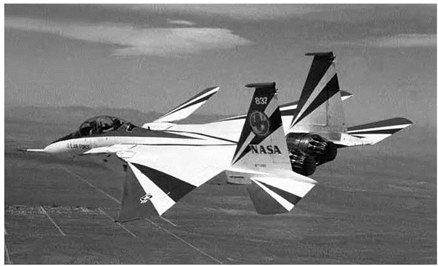NF-15B Advanced Control Technology: Air Force S/MTD
NASA Dryden used an NF-15B research aircraft on various research projects from 1993 through early 2009. Originally designated the TF-15, it was the first two-seat F-15 Eagle built by McDonnell-Douglas, the sixth F-15 off the assembly line, and the oldest F-15 flying up to its retirement. First flown in July 1973, the aircraft was initially used for F-15 developmental testing and evaluation as part of the F-15 combined test force at Edwards AFB in the 1970s. In the 1980s, the aircraft was extensively modified for the Air Force’s Short Takeoff and Landing Maneuver Technology Demonstrator (S/MTD) program. Modifications included the integration of a digital fly-by-wire control system, canards mounted on the engine inlets ahead of the wings,[1273] and two-dimensional thrustvectoring, thrust-reversing nozzles. The vectoring nozzles redirected
 |
|
engine exhaust either up or down, giving greater pitch control and additional aerodynamic braking capability. Designated NF-15B to reflect its status as a highly modified research aircraft, the aircraft was used in the S/MTD program from 1988 until 1993. During Air Force S/MTD testing, a 25-percent reduction in takeoff roll was demonstrated with thrust-reversing, enabling the aircraft to stop in just 1,650 feet. Takeoffs using thrust-vectoring produced nose rotation speeds as low as 40 knots, resulting in greatly reduced takeoff distances. Additionally, thrust-reversing produced extremely rapid in-flight decelerations, a feature valuable during close-in combat.[1274]










